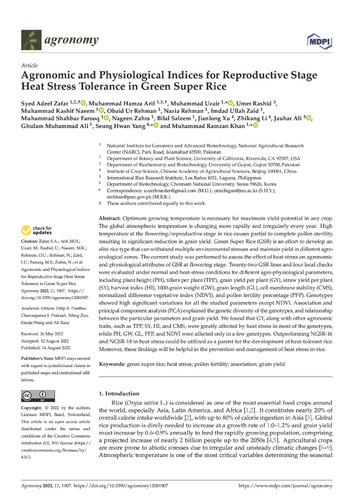Agronomic and physiological indices for reproductive stage heat stress tolerance in green super rice
Abstract
Optimum growing temperature is necessary for maximum yield-potential in any crop. The global atmospheric temperature is changing more rapidly and irregularly every year. High temperature at the flowering/reproductive stage in rice causes partial to complete pollen sterility, resulting in significant reduction in grain yield. Green Super Rice (GSR) is an effort to develop an elite rice type that can withstand multiple environmental stresses and maintain yield in different agro-ecological zones. The current study was performed to assess the effect of heat stress on agronomic and physiological attributes of GSR at flowering stage. Twenty-two GSR lines and four local checks were evaluated under normal and heat-stress conditions for different agro-physiological parameters, including plant height (PH), tillers per plant (TPP), grain yield per plant (GY), straw yield per plant (SY), harvest index (HI), 1000-grain weight (GW), grain length (GL), cell membrane stability (CMS), normalized difference vegetative index (NDVI), and pollen fertility percentage (PFP). Genotypes showed high significant variations for all the studied parameters except NDVI. Association and principal component analysis (PCA) explained the genetic diversity of the genotypes, and relationship between the particular parameters and grain yield. We found that GY, along with other agronomic traits, such as TPP, SY, HI, and CMS, were greatly affected by heat stress in most of the genotypes, while PH, GW, GL, PFP, and NDVI were affected only in a few genotypes. Outperforming NGSR-16 and NGSR-18 in heat stress could be utilized as a parent for the development of heat-tolerant rice. Moreover, these findings will be helpful in the prevention and management of heat stress in rice.

